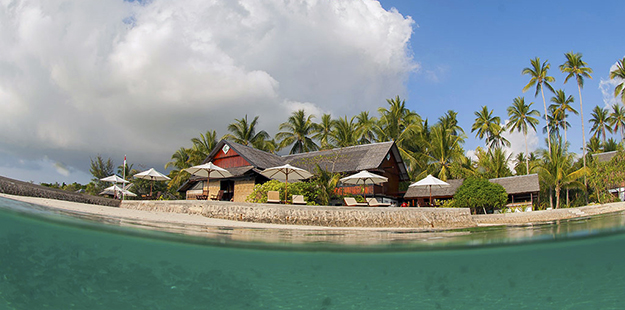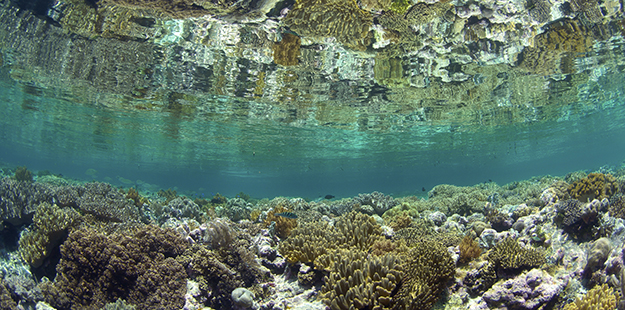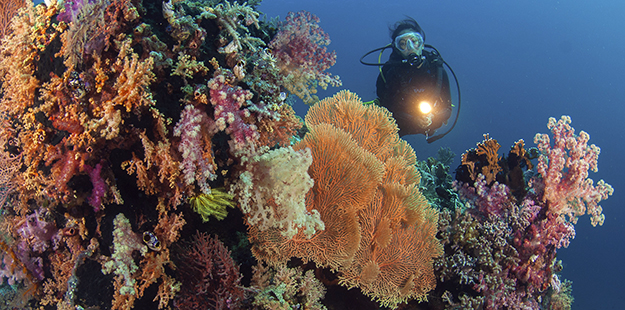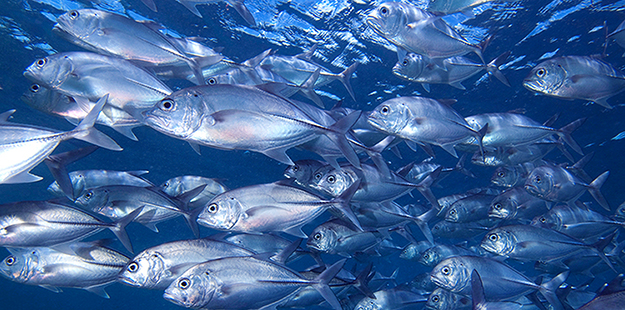An Underwater Photographer’s Guide to Wakatobi
Photos and text by Richard Smith
Wakatobi is ideally placed in the heart of the Coral Triangle, a region that encompasses the Philippines, Indonesia, Malaysia, Papua New Guinea and the Solomon Island. For underwater photographers seeking a diversity of marine life subjects, this is the place to be, because the waters of the triangle support the highest biodiversity of marine organisms in the world.
Unspoiled and pristine form
But while the Coral Triangle is indeed home to a diverse and rich collection of species, it also has some of the greatest man-made stresses, with reefs subject to the pressures of destructive fishing practices and development. Luckily, there are places where nature still exists in an unspoiled and pristine form, and a two-hour flight on the resort’s private charter from Bali to Wakatobi will transport you to a remote corner of the world that the resort has worked tirelessly to protect.

This is a split image of the Wakatobi longhouse taken just off the beach on the House Reef. Image taken using a 10.5 mm fish eye lens. F9, 1/125th, ISO 100. Photo by Richard Smith
Diligent conservation and protection efforts within Wakatobi’s privately-maintained marine preserve provide dive sites covered in a kaleidoscope of soft corals and sponges that swarm with life, and tumble downward from bright shallows to disappear into the abyssal blue below. Ridges and seamounts bring life-giving sunlight to hard corals, and unsullied bays provide the protection needed for the reef’s more delicate creatures to flourish.
Easily accessible from shore, the shallow reef crest in front of the resort dramatically plunges to several hundred feet in depth. Here turtles, trevally, frogfish, ghost pipefish and four species of pygmy seahorses find their home on a reef that tears the underwater photographer’s attentions from macro to wide-angle in the blink of an eye.
Given the wide variety of subjects, SLR shooters should bring a full compliment of lenses. For macro, my personal preference is 100/105 mm, which gives you a bit of space between yourself and the smaller, more shy creatures. The great visibility means there shouldn’t be an issue with sediment in the water. Fisheye lenses are excellent in the shallows; making the most of the high coral coverage and Snell’s window in the calm waters.

The House Reef is one of Wakatobi’s most well known dive sites, and in my opinion it is the best shallow water site in the world. Image taken using a 10.5 mm fisheye lens. F9, 1/125th, ISO 100. Photo by Richard Smith

Among the highlights of macro subjects you will find at Wakatobi are four species of pygmy seahorse, plus the recently described pygmy pipehorse ( Kyonemichthys rumengani), seen here. Image taken using a 105 mm macro lens. F22, 1/125th, ISO 100. Photo by Richard Smith
Macro galore
There is a wealth of macro subjects to discover at Wakatobi, and it is these that the resort is perhaps most well known for. Indeed, one could spend an entire week within 100 yards of the resort pier and not exhaust the area’s macro potential. Among the highlights of subjects you will find are a huge variety of nudibranchs, abundant anemonefishe; numerious shrimp species including imperial, bubble coral and crinoid; robust, ornate and halimeda ghost pipe fish; four species of pygmy seahorses – Bargibant’s, Denise’s, Pontoh’s and Severn’s, and the recently described pygmy pipehorse, Kyonemichthys rumengani.

Denise’s pygmy seahorses are one of the four pygmy species found around the resort. Image taken using a 105 mm macro lens. F22, 1/125th, ISO 100. Photo by Richard Smith
Much of the marine life at Wakatobi can be shot using a compact camera with a strobe. Some of the smallest creatures might be just that little bit too small, so you’ll probably benefit from an external macro lens, while a wide or fisheye wet lens will enhance your creativity for reef scenes.
Don’t forget to go big
But although it is easy for photographers to get lost in capturing the small details, it would be a shame to miss the big picture. The reefs here are absolutely stunning and should not be forgotten by the wide-angle photographer. Walls that begin in shallow depths are covered in a diverse array of soft corals, sponges and gorgonians. The clear waters provide ample ambient light to showcase these vistas in vibrant detail. Similar scenes can be captured on seamounts covered in hard corals, and it is common to find green and hawksbill turtles as amenable subjects, or to come upon swirling schools of big-eye trevally, bumphead parrotfish and barracuda.
The diversity of dive sites, along with the wide range of marine life at Wakatobi is such that you’ll regret leaving any photo gear at home. Almost all dives are ideal for both macro and wide, but your guide can help you reach an informed decision for each particular site.

I prefer using the 100/105mm macro lens for photographing tiny, shy creatures, such as this nudibranch found at the site Teluk Maya. Photo by Richard Smith

A diver inspects a vibrant coral head at Wakatobi. Image taken using a 10.5 mm fish eye lens. F5.6, 1/125th, ISO 100. Photo by Richard Smith
As always, keep a close eye on your buoyancy. The reefs of Wakatobi are so rich with life, and every square centimeter inhabited, that finding even a small bare patch to steady yourself can sometimes be troublesome. As part of its environmentally conscious philosophy, the resort takes great pride in its marine life. Your guide will help you avoid any accidental damage whilst taking photos, particularly with delicate macro subjects.
As well as the three boat dives offered per day, you also have unlimited access to the House Reef from 6 am to 10pm. You can either choose to go directly from shore, or get dropped off down the reef by boat, depending on the current. The beauty of diving the House Reef is that you can go as slowly as you like, making the most of the abundant macro and wide-angle photography opportunities.

Even Wakatobi’s shallow depths are covered in a diverse array of soft corals, sponges and gorgonians. Image taken using a 10.5 mm fish eye lens. F5.6, 1/125th, ISO 100. Photo by Richard Smith
If you have a moment, take a look at the reef from a different perspective. The huge variety of invertebrates such as soft corals, anemones and sponges provide a rich palette of unique abstract subjects. On virtually every dive, both macro and wide-angle will be great but it is worth checking with your guide whether there are any specialties you should know about. The sites Kollo Soha and Teluk Maya are two that are definitely worthy of a dedicated macro shoot.
Take it all
Baggage capacity is never an issue from Bali to over to Wakatobi, as the resort’ private charter flight with the Garuda Group is designed to so that guests can bring all their equipment and gear with them. If this becomes an issue on your international flight, I would be inclined to leave some dive gear behind in favor of camera accessories; Wakatobi Dive Resort has a very well kitted out dive center where you can hire all your gear should you decide against traveling with it, or experience a technical glitch during your trip.
Macro Highlights
A huge variety of Nudibranchs
Abundant anemonefishes
Various shrimp species: imperial, bubble coral and crinoid to name a few
Ghost pipefish: robust, ornate and halimeda
Four species of pygmy seahorse: Bargibant’s, Denise’s, Pontoh’s and Severn’s
The recently described pygmy pipehorse, Kyonemichthys rumengani
Wide-angle Subjects
Stunning soft corals, sponges and gorgonians on walls
Hard corals on seamounts
Green and Hawksbill turtles
Schooling fish: big-eye trevally, bumphead parrotfish, snapper and barracuda
Tips and Techniques for Photography at Wakatobi
Peak Performance Buoyancy: As always, keep a close eye on your buoyancy. The reefs of Wakatobi are so rich with life, and every square centimetre inhabited, that finding even a small bare patch to steady yourself can sometimes be troublesome. Luckily, your guide will happily provide stability should you need some assistance.
Make the most of the House Reef: As well as the three boat dives offered per day, you also have unlimited access to the House Reef from 6am. You can either choose to go directly from shore, or get dropped off down the reef, depending on the current. The beauty of diving the House Reef is that you can go as slowly as you like, making the most of the abundant macro and wide-angle photography opportunities.
Look for abstracts: If you have a moment, take a look at the reef from a different perspective. The huge variety of invertebrates such as soft corals, anemones and sponges provide a rich palette of unique abstract subjects.
Check the best lens for the dive: On virtually every dive, both macro and wide-angle will be great but it is worth checking with your guide whether there are any specialities you should know about. The sites Kollo Soha and Teluk Maya are two that are definitely worth using macro for.
Wakatobi Facts
Where: Southeast Sulawesi, Indonesia
Language: Bahasa Indonesia
Currency: Rupiah (IRP), as well as US dollars and Euros at the resort
Time Zone: GMT + 8 hrs
Water Temperature: 26C 30ËšC (78 – 86ËšF)
Surface Temperature: 26 € 30ËšC (78 – 86ËšF)
Visibility: 50 m +
Diving Experience Level: Being warm and clear, it is largely suitable for beginners, although currents can occasionally be experienced at some sites
Photography Experience Level: Ideal for beginner and advanced photographers alike
Ready to visit Wakatobi? Contact their office at office@wakatobi.com. Complete a quick trip inquiry at wakatobi.com. A guest experience consultant will be in touch with you to answer any questions and discuss your next underwater photography vacation.
Learn more about Richard Smith on facebook.



